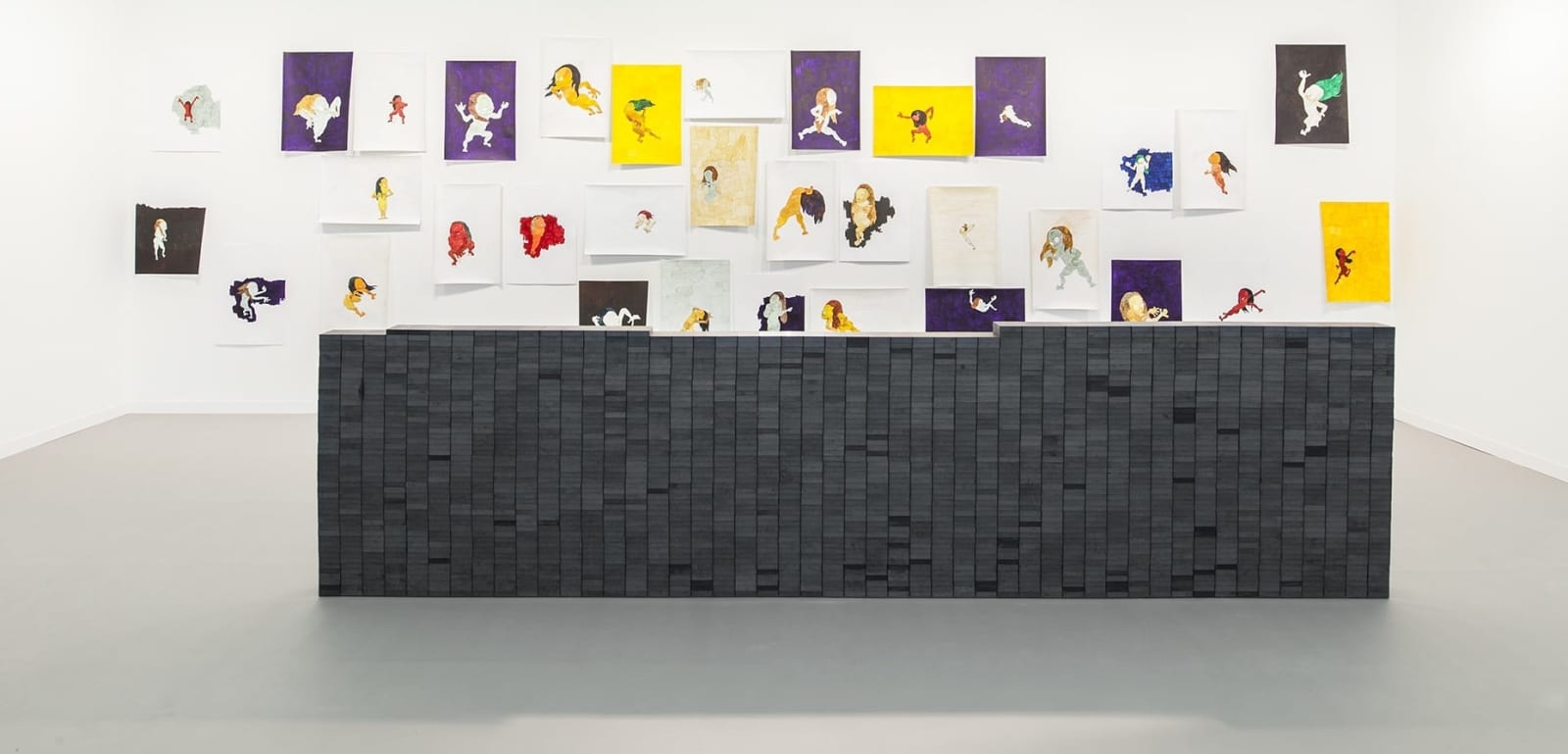
Koo Jeong A
Invisible Hands, 2014
2,400 Ferrite magnet units, 28 watercolours on paper
Magnet Wall: overall dimensions, 120 x 500 x 15 cm (approx)
Watercolours: 27 sheets: 84.1 x 59.4 cm; 6 sheets: 59.4 x 84.1 cm
Installation dimensions variable
Watercolours: 27 sheets: 84.1 x 59.4 cm; 6 sheets: 59.4 x 84.1 cm
Installation dimensions variable
Copyright The Artist
The installation 'Invisible Hands' (2014) comprises a sculpture of magnets 'Cedric & FRAND' (2014) alongside a series of 33 watercolours on paper, collectively titled 'Invisible Hands' (2014). Koo Jeong A...
The installation 'Invisible Hands' (2014) comprises a sculpture of magnets 'Cedric & FRAND' (2014) alongside a series of 33 watercolours on paper, collectively titled 'Invisible Hands' (2014). Koo Jeong A is fascinated by the properties of magnetic fields and the way the aggregation of magnets simulates the pull and push of human networks, she is also inspired by the English architect Cedric Price (1934 – 2003). While only one of Price’s schemes was ever built, the Aviary at London Zoo in 1961, he was prolific in his architectural designs. One of his later projects in 1997 was Magnet, an unrealised project where Price used ‘anticipatory architecture’ to devise ten city structures that, via public amenities, would stimulate new patterns of public movement. It is this project that has particularly influenced Koo in her work.
For Koo, the aggregation of units and magnets represent a kind of assembly or network and reflects how we congregate in society, reproducing a kind of alternative mode of connection and network between people as opposed to unilateral and concentrated form of power. In the piece 'Cedric & FRAND', Koo directly references Price while ‘FRAND’ stands for ‘fair, reasonable and non-discriminatory’ – the rules that govern patent licensing. Koo has employed magnets previously in her work, one of which, 'Cedric' (2003), is included in the Tate’s permanent collection. The piece 'Cedric & FRAND' (2014) marks the first time that Koo has used magnets on such a large scale. Comprising 2,400 ferrite magnet units, the work considers how electromagnetic power governs the universe, an invisible force affecting all of the living creatures within it.
Complementing the sculpture are the 'Invisible Hands' watercolours. The title of the series is a reference to Scottish philosopher and political economist Adam Smith’s metaphor of "the invisible hand". For Smith the invisible hand is the natural regulatory force that underpins liberal markets - each individual acts in their own personal interest but the overall market self-regulates. This is the base of liberal and unregulated economy. The gestures of the characters in Koo’s drawings reflect the hand gestures made by brokers who work in the stock exchange. The characters’ names are taken from the trading names of small companies.
For Koo, the aggregation of units and magnets represent a kind of assembly or network and reflects how we congregate in society, reproducing a kind of alternative mode of connection and network between people as opposed to unilateral and concentrated form of power. In the piece 'Cedric & FRAND', Koo directly references Price while ‘FRAND’ stands for ‘fair, reasonable and non-discriminatory’ – the rules that govern patent licensing. Koo has employed magnets previously in her work, one of which, 'Cedric' (2003), is included in the Tate’s permanent collection. The piece 'Cedric & FRAND' (2014) marks the first time that Koo has used magnets on such a large scale. Comprising 2,400 ferrite magnet units, the work considers how electromagnetic power governs the universe, an invisible force affecting all of the living creatures within it.
Complementing the sculpture are the 'Invisible Hands' watercolours. The title of the series is a reference to Scottish philosopher and political economist Adam Smith’s metaphor of "the invisible hand". For Smith the invisible hand is the natural regulatory force that underpins liberal markets - each individual acts in their own personal interest but the overall market self-regulates. This is the base of liberal and unregulated economy. The gestures of the characters in Koo’s drawings reflect the hand gestures made by brokers who work in the stock exchange. The characters’ names are taken from the trading names of small companies.